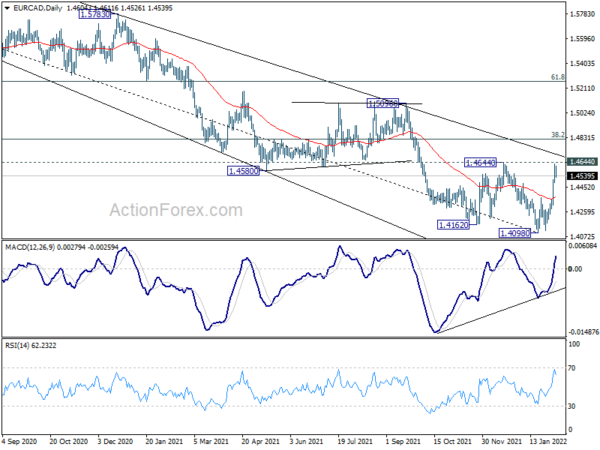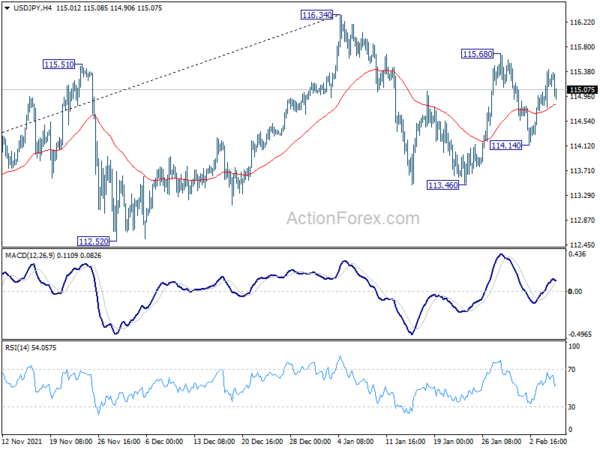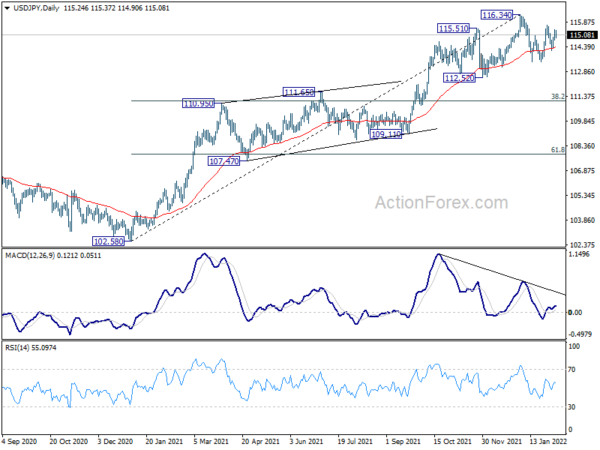Australian Dollar is leading commodity currencies higher in relatively quiet trading today. Swiss Franc is also firm, but mainly because Euro is consolidation gains. Sterling is currently the weakest one, followed by Euro and then Dollar, while Yen is mixed. In other markets, major European indexes are trading water while US futures point to slightly higher open. Gold is trading above 1800 handle but lacks follow through buying so far. WTI crude oil is holding on well to 92 handle for further rally.
Technically, in addition to 1.1482 resistance in EUR/CAD. We’ll also pay close attention to 1.4644 resistance in EUR/CAD. Sustained break there will be a sign of medium term bullish reversal and turn focus to 38.2% retracement of 1.5991 to 1.4098 at 1.4821. Euro will have to break through these two levels with some conviction if the trend reversal is for real.
In Europe, at the time of writing, FTSE is up 0.63%. DAX is up 0.47%. CAC is up 0.39%. Germany 10-year yield is up 0.011 at 0.221. Earlier in Asia, Nikkei dropped -0.70%. Hong Kong HSI rose 0.02%. China Shanghai SSE rose 2.03%. Singapore Strait Times rose 1.05%. Japan 10-year JGB yield dropped -0.0007 to 0.200.
Eurozone Sentix investor confidence rose to 15.2, lack of sustainable new growth drivers
Eurozone Sentix Investor Confidence rose from 14.9 to 15.2 in February, above expectation of 15.2. Current situation index rose from 16.3 to 19.3. Expectations index rose from 13.5 to 14.0, highest since July.
Sentix said: “The economic situation in Euroland is stable in February 2022. The situation and expectations of the more than 1,200 investors surveyed by sentix signal a slight improvement. Thus, our assumption that we are in a “mid-cycle slowdown”, i.e. a growth moderation in the middle of an economic cycle, which we have been expressing here for months, remains unchanged. However, this phase of moderation is not yet complete. There is a lack of sustainable new growth drivers. Above all, there is a lack of impetus from the international economy.”
Also released, Germany industrial production dropped -0.3% mom in December versus expectation of 0.8% mom. Swiss unemployment rate dropped from 2.4% to 2.3% in January. Swiss foreign currency reserves rose slightly to CHF 947B in January.
ECB Kazaks: July hike imply an imply an extremely and unlikely quick pace of tapering
ECB Governing Council member Martins Kazaks said in a Reuters interview that a July rate hike “would imply an extremely and unlikely quick pace of tapering”. Overall, “at the current juncture, naming a specific month would be much premature.”
“If we see that inflation remains high and the labor market remains strong or strengthens further, if we see that the economy keeps going, the direction is clear: we may act sooner than we assumed in the past,” he added.
Over the weekend, another Governing Council member Klass Knot said, “personally I expect our first rate increase to take place around the fourth quarter of this year…. Normally we would raise rates by a quarter percentage point, I have no reason to expect we would take a different step.”
Australia AiG services rose to 56.2, rising sales, employment and new orders
Australia AiG Performance of Services Index rose 6.6 pts to 56.2 in January, hitting the highest level since June last year. Looking at some details, sales rose 5.3 to 58.9. Employment rose 0.5 to 56.7. New orders rose 10.5 to 57.9. Supplier deliveries rose 11.0 to 51.4. Input prices rose 0.8 to 66.1. Selling prices rose 4.0 to 62.2. Average wages dropped -2.9 to 56.9.
Innes Willox, Chief Executive of Ai Group, said: “The performance of Australia’s services sector rose over the December-January period with sales, employment and new orders all growing compared with November…. Businesses reported a slight easing of input price and wages pressures compared with November while selling prices rose indicating a belated and partial recovery of earlier cost rises. The rise in employment, while encouraging, came alongside numerous reports of the unavailability of staff and appears likely to reflect businesses hiring staff to cover for the workforce impacts of the Omicron wave.”
Australia retail sales dropped -4.4% in Dec, up 8.2% in Q4
Australia retail sales dropped -4.4% mom in December to AUD 31.93B. For Q4, sales rose 8.2%, fastest on record.
Ben James, Director of Quarterly Economy Wide Statistics, said: “Consumers enthusiastically returned to discretionary spending following the end of Delta related lockdowns in October, and the continued easing of restrictions over the quarter. Well publicised concerns over product availability and delivery timeliness led to consumers bringing forward their end of year shopping, in conjunction with a re-opening spending splurge due to pent up consumer demand.”
“This post lockdown recovery aligns well with the previous nationwide Covid lockdown recovery in the September quarter 2020 where sales rose 6.3 per cent, more than recovering the losses of the June 2020 quarter fall of 3.5 per cent”.
China PMI composite dropped to 50.1, triple pressures of contracting demand, supply shocks and weakening expectations
China PMI Services dropped from 53.1 to 51.4 in January, above expectation of 50.5. PMI Composite dropped from 53.0 to 50.1.
Wang Zhe, Senior Economist at Caixin Insight Group said: “To sum up, both the manufacturing and services sectors weakened in January. Activity in the manufacturing sector shrank. Domestic demand was subdued, and overseas demand largely declined. The labor market remained under pressure. The gauges for input and output prices were stable, while the high prices of some raw materials remained a concern. The level of optimism among service enterprises declined.
“In December and January, the resurgence of Covid-19 in several regions such as Xi’an and Beijing forced local governments to tighten epidemic control measures, which restricted production, transportation and sales of goods. It has become more evident that China’s economy is straining under the triple pressures of contracting demand, supply shocks and weakening expectations.”
USD/JPY Mid-Day Outlook
Daily Pivots: (S1) 114.84; (P) 115.13; (R1) 115.49; More…
USD/JPY is still bounded in sideway trading and intraday bias remains neutral. Consolidation from 116.34 is still extending. On the upside, break of 115.68 will resume the rebound from 113.46 to retest 116.34 high first. On the downside, break of 114.14 should extend the consolidation with another falling leg through 113.46 support.
In the bigger picture, no change in the view that rise from 102.58 is the third leg of the up trend from 101.18 (2020 low). Such rally should target a test on 118.65 (2016 high). Sustained break there will pave the way to 120.85 (2015 high) and raise the chance of long term up trend resumption. This will remain the favored case as long as 55 week EMA (now at 111.21) holds.
Economic Indicators Update
| GMT | Ccy | Events | Actual | Forecast | Previous | Revised |
|---|---|---|---|---|---|---|
| 21:30 | AUD | AiG Performance of Services Index Jan | 56.2 | 49.6 | ||
| 01:45 | CNY | Caixin Services PMI Jan | 51.4 | 50.5 | 53.1 | |
| 05:00 | JPY | Leading Economic Index Dec P | 104.3 | 103.1 | 103.2 | |
| 06:45 | CHF | Unemployment Rate Jan | 2.30% | 2.40% | 2.40% | |
| 07:00 | EUR | Germany Industrial Production M/M Dec | -0.30% | 0.80% | -0.20% | |
| 08:00 | CHF | Foreign Currency Reserves (CHF) Jan | 947B | 945B | ||
| 09:30 | EUR | Eurozone Sentix Investor Confidence Feb | 16.6 | 15.2 | 14.9 |
















